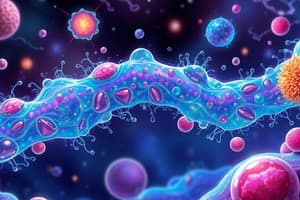Podcast
Questions and Answers
What is the primary role of nutrients in microbial cells?
What is the primary role of nutrients in microbial cells?
- They help in maintaining cell shape and size.
- They assist in waste elimination processes.
- They are used to form chemical compounds necessary for growth. (correct)
- They are only used for energy storage.
Which of the following elements is NOT considered a major component of microbial cell dry weight?
Which of the following elements is NOT considered a major component of microbial cell dry weight?
- Calcium
- Oxygen
- Nitrogen
- Iron (correct)
Which nutrient source is categorized as an autotroph?
Which nutrient source is categorized as an autotroph?
- Proteins
- Fatty acids
- Glucose
- Carbon Dioxide and Sunlight (correct)
What is the need for raw materials in microbial growth?
What is the need for raw materials in microbial growth?
What is one major function of phosphorus in microbial cells?
What is one major function of phosphorus in microbial cells?
What characterizes active transport in cellular processes?
What characterizes active transport in cellular processes?
How does hydrolysis of ATP affect carrier proteins during active transport?
How does hydrolysis of ATP affect carrier proteins during active transport?
What is the main function of group translocation in cellular transport?
What is the main function of group translocation in cellular transport?
Which system is best known for illustrating group translocation?
Which system is best known for illustrating group translocation?
What energy source is primarily utilized in the group translocation process?
What energy source is primarily utilized in the group translocation process?
What is the primary method used in the pour plate technique to create bacterial colonies?
What is the primary method used in the pour plate technique to create bacterial colonies?
Which of the following morphological characteristics is NOT typically used to identify bacterial colonies?
Which of the following morphological characteristics is NOT typically used to identify bacterial colonies?
What is a typical characteristic of E. coli colonies when grown on MacConkey agar?
What is a typical characteristic of E. coli colonies when grown on MacConkey agar?
For long-term storage of bacterial cultures, which condition is most appropriate?
For long-term storage of bacterial cultures, which condition is most appropriate?
What characteristic of Klebsiella sp. colonies on MacConkey agar is noted after 48 hours of growth?
What characteristic of Klebsiella sp. colonies on MacConkey agar is noted after 48 hours of growth?
What is the result of beta hemolysis on blood agar?
What is the result of beta hemolysis on blood agar?
Which of the following statements is true about mannitol salt agar?
Which of the following statements is true about mannitol salt agar?
What is one technique used to isolate a pure culture from a mixed culture?
What is one technique used to isolate a pure culture from a mixed culture?
Which media is specifically designed for chromogenic detection of Candida species?
Which media is specifically designed for chromogenic detection of Candida species?
What is indicated by gamma hemolysis on blood agar?
What is indicated by gamma hemolysis on blood agar?
What is the primary purpose of enriched media?
What is the primary purpose of enriched media?
Which of the following is an example of selective media?
Which of the following is an example of selective media?
How does MacConkey agar differentiate between lactose fermenters and non-fermenters?
How does MacConkey agar differentiate between lactose fermenters and non-fermenters?
Which statement accurately describes the role of bile salts and crystal violet dye in MacConkey agar?
Which statement accurately describes the role of bile salts and crystal violet dye in MacConkey agar?
What characterizes differential media?
What characterizes differential media?
What would be the appearance of E.coli on MacConkey agar?
What would be the appearance of E.coli on MacConkey agar?
What is the function of the neutral red dye in MacConkey agar?
What is the function of the neutral red dye in MacConkey agar?
Which of the following media is NOT classified as enriched media?
Which of the following media is NOT classified as enriched media?
What is the primary difference between autotrophs and heterotrophs?
What is the primary difference between autotrophs and heterotrophs?
Which macronutrient is essential for the stabilization of ribosomes and cell membranes?
Which macronutrient is essential for the stabilization of ribosomes and cell membranes?
Which of the following is not classified as a micronutrient?
Which of the following is not classified as a micronutrient?
What role do electrons play in cellular processes?
What role do electrons play in cellular processes?
Which combination correctly describes the nutritional types of microorganisms?
Which combination correctly describes the nutritional types of microorganisms?
Which of the following elements is considered a macronutrient necessary for protein synthesis?
Which of the following elements is considered a macronutrient necessary for protein synthesis?
Which element represents one of the six most important components of biological molecules on Earth?
Which element represents one of the six most important components of biological molecules on Earth?
What is a key feature of lithotrophs in their nutritional classification?
What is a key feature of lithotrophs in their nutritional classification?
Flashcards
What are nutrients?
What are nutrients?
Chemical substances taken from the environment used for cellular growth.
Why are nutrients important?
Why are nutrients important?
Nutrients provide the building blocks for hundreds of molecules within a cell.
Major elements
Major elements
Elements that form the majority of a cell's dry weight.
Autotrophs
Autotrophs
Signup and view all the flashcards
Heterotrophs
Heterotrophs
Signup and view all the flashcards
Macronutrients
Macronutrients
Signup and view all the flashcards
Micronutrients
Micronutrients
Signup and view all the flashcards
Carbon
Carbon
Signup and view all the flashcards
Phototrophs
Phototrophs
Signup and view all the flashcards
Chemotrophs
Chemotrophs
Signup and view all the flashcards
Lithotrophs
Lithotrophs
Signup and view all the flashcards
Organotrophs
Organotrophs
Signup and view all the flashcards
Active Transport
Active Transport
Signup and view all the flashcards
Group Translocation
Group Translocation
Signup and view all the flashcards
Energy Source for Active Transport
Energy Source for Active Transport
Signup and view all the flashcards
Carrier Proteins in Active Transport
Carrier Proteins in Active Transport
Signup and view all the flashcards
Phosphoenolpyruvate:sugar Phosphotransferase System (PTS)
Phosphoenolpyruvate:sugar Phosphotransferase System (PTS)
Signup and view all the flashcards
Beta hemolysis
Beta hemolysis
Signup and view all the flashcards
Alpha hemolysis
Alpha hemolysis
Signup and view all the flashcards
Gamma hemolysis
Gamma hemolysis
Signup and view all the flashcards
Differential medium
Differential medium
Signup and view all the flashcards
Selective medium
Selective medium
Signup and view all the flashcards
Enriched Media
Enriched Media
Signup and view all the flashcards
Blood Agar
Blood Agar
Signup and view all the flashcards
Chocolate Agar
Chocolate Agar
Signup and view all the flashcards
Lowenstein-Jensen (LJ) Medium
Lowenstein-Jensen (LJ) Medium
Signup and view all the flashcards
MacConkey Agar
MacConkey Agar
Signup and view all the flashcards
Eosin Methylene Blue (EMB) Agar
Eosin Methylene Blue (EMB) Agar
Signup and view all the flashcards
Pour Plate Technique
Pour Plate Technique
Signup and view all the flashcards
Bacterial Colony Morphology
Bacterial Colony Morphology
Signup and view all the flashcards
Margin of a Bacterial Colony
Margin of a Bacterial Colony
Signup and view all the flashcards
Optical Properties of Bacterial Colonies
Optical Properties of Bacterial Colonies
Signup and view all the flashcards
Glycerol Stock for Bacterial Storage
Glycerol Stock for Bacterial Storage
Signup and view all the flashcards
Study Notes
Microbial Nutrition
- Microbial nutrition is the study of how microorganisms acquire and use nutrients for growth.
Nutrients
- Nutrients are chemical substances obtained from the environment, used by cellular activities for growth.
- Essential for forming hundreds of chemical compounds within a living cell.
Macroelements
- Essential chemical components required in large amounts during microbial growth.
- Examples include carbon (C), oxygen (O), hydrogen (H), nitrogen (N), sulfur (S), phosphorus (P), potassium (K), calcium (Ca), magnesium (Mg), and iron (Fe).
Micronutrients
- Essential chemical components needed in very small amounts for microbial growth.
- Examples include manganese (Mn), zinc (Zn), cobalt (Co), molybdenum (Mo), nickel (Ni), and copper (Cu).
Organic Building Blocks
- The acronym CHNOPS (carbon, hydrogen, nitrogen, oxygen, phosphorus, and sulfur) represents six essential elements for building biological molecules on Earth.
- These elements form hydrocarbons, carbohydrates, lipids, amino acids, proteins, nucleic acids (RNA and DNA), and other vital molecules.
Growth Factors
- Organic compounds crucial for cell function; the organism cannot synthesize these on their own.
- Essential components or precursors for cell survival and reproduction.
- Divided into three major classes:
- Amino acids: required for protein synthesis
- Purines and pyrimidines: needed for nucleic acid synthesis
- Vitamins: function as enzyme cofactors
Nutrient Uptake
- Microorganisms use several methods to absorb nutrients:
- Simple diffusion
- Facilitated diffusion
- Active transport
- Group translocation
- Endocytosis
Culture Media
- Culture media are substances supplying all the nutrients required for microbial growth.
- Classified based on:
- Physical nature
- Liquid: defined or complex, supportive
- Semisolid
- Solid: defined or complex, enriched, selective or differential
- Chemical composition
- Complex: contains undefined ingredients
- Defined: precisely known chemical composition, suitable for fastidious organisms
- Functional type (purpose)
- Supportive (general purpose)
- Support microorganisms' growth
- Enriched
- Contains extra nutrients to support fastidious organisms' growth
- Selective
- Promotes certain microorganisms' growth while hindering others' growth
- Differential
- Helps distinguish microorganisms based on different biological characteristics
- Supportive (general purpose)
- Physical nature
Isolation of Pure Cultures
- Techniques like streak plating, spread plating, and pour plating help isolate pure cultures.
- Crucial for studying bacteria or microbes in detail and isolating a specific type.
Studying That Suits You
Use AI to generate personalized quizzes and flashcards to suit your learning preferences.
Related Documents
Description
Test your knowledge on the essential roles of nutrients in microbial cells, the mechanisms of nutrient transport, and the identification of bacterial colonies. This quiz covers a range of topics, including autotrophy, group translocation, and the characteristics of various bacteria. Challenge yourself and see how much you know about microbial growth and metabolism!




